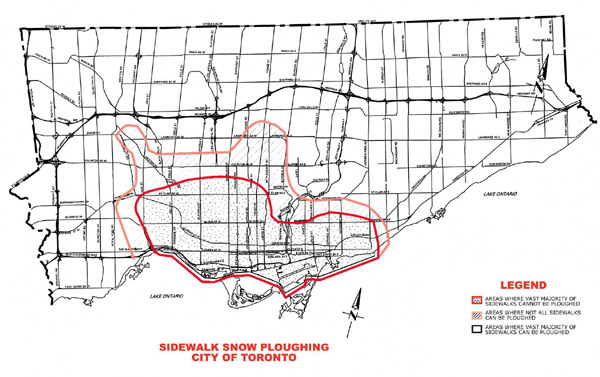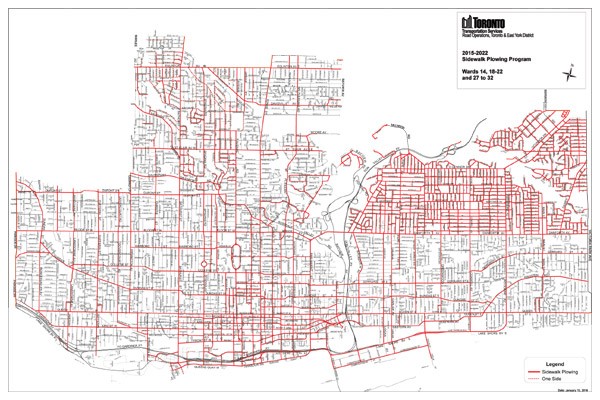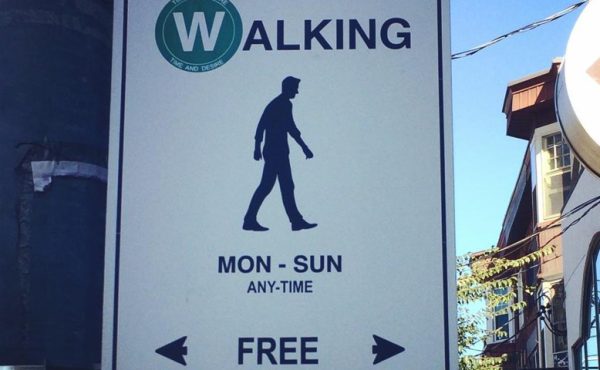In the City of Toronto, the city will clear some local sidewalks when it snows a certain amount, but other people are required to shovel their sidewalk whenever it snows (unless they are part of the city program (PDF) for seniors and the disabled). Those who are required to shovel their sidewalks can be subject to fines if they don’t — but until recently, there was no map that showed exactly who had this responsibility. There was only a vague map of general “zones” — in general, the old city of Toronto sidewalks were not ploughed, but those in the amalgamated suburban municipalities were.

The City has finally produced a detailed map of most of the “no-plough” zone, showing which sidewalks are never ploughed by the city and thus have to be shovelled by property owners (top image). You can see the full map here (PDF). The map only covers the Toronto East York District so far, and so leaves out some areas of mixed ploughing in the west and north.
The city ploughs all arterial and collector sidewalks. As well, you can see, in the map, that the city also ploughs a certain number of residential sidewalks within the no-plough zone — in and near the former municipality of East York, and in Forest Hill. These areas were continued from previous amalgamations of municipalities that provided the service (and in East York, ploughing was extended past the old East York boundary to the rest of the area north of the Danforth).
It’s striking that some sidewalks that are ploughed are not much different from those that aren’t. The City explains the continued lack of ploughing of old city sidewalks by saying they are too narrow and have too many obstacles (poles, fences, street parking, etc) and not enough place to put snow. But many streets north of the Danforth are little different in size and configuration from those south. And streets like Logan Ave. and Carlaw Ave., which are ploughed south of the Danforth because they’re collectors, are little different from other residential sidewalks.

Another important consideration is that, even if the City ploughs your sidewalk, you still have a lot of responsibility for it. The City will only plough local sidewalks after 8 cm of snow — that’s quite a lot. As well, the City only promises to plough your sidewalk within 48 hours (PDF) — meaning it’s potentially a dangerous obstacle for people with mobility difficulties for up to 2 days. So, if you are physically able, even if you live in the plough zone it is still best to shovel your sidewalk to create a safe environment for your neighbours. City ploughing of local sidewalks is best thought of as a backup for those for whom shovelling snow is a physical burden, through age, injury, disability, absence, etc. And, beyond snow, every property owner has a separate responsibility to put grit or a melting agent like salt on their local sidewalk if it gets icy (Municipal Code Chapter 719-2-B (PDF)).
As of this year, the situation for “High Volume Pedestrian Routes” (PDF) — that’s mostly arterials and collectors — is better. The City will plow those after as little as 2 cm of snow, and lay down salt as well to melt any residue. And it will do this in conjunction with road clearing, so that they should be clear within a few hours. This new standard is a welcome improvement that means some property owners can leave the work to the City along these streets (which often feature retail, offices, and/or residential apartments). However, the City did not identify which sidewalks receive this higher level of service on the map, so it’s still not entirely clear what level of service people should expect in various locations. City staff have indicated that they will provide more detailed maps, that cover the entire city, in the future.
Disclosure: the new map was produced in response to a proposal from Walk Toronto, of which I am a steering committee member.




4 comments
The problem is in that older sections of the city, hydro poles, signs posts, hydrants, etc. may take up sidewalk space. This resists the use of the sidewalk plows. Yet, I’ve seen sidewalk plows operate on sidewalks with such obstacles. Just use plows that can operate on such narrow sidewalks.
The City is still liable in the event of injury. A Bylaw fine may be levied against the property owner but they cannot escape legal responsibility.
The downside to the city doing all this is it takes away an entrepreneurial work opportunity from people who could use the extra cash. I’d really rather the city was just stricter with applying fines to any property owner who didn’t shovel, and left the opportunity open to other to economically fill the gap.
Why not pay the guy up the street $20 to shovel my sidewalk to avoid the city fining me $200. Letting people document unshovelled sidewalks and get a share of the fine levelled would probably help the city collect enough to make it worth enforcing.
The narrow sidewalk excuse is such bollocks when you consider that in Montreal they clear and salt all sidewalks then come back and actually remove all of the snow. I’m fairly certain that the sidewalks in Old Montreal are considerably more narrow than any in Toronto.